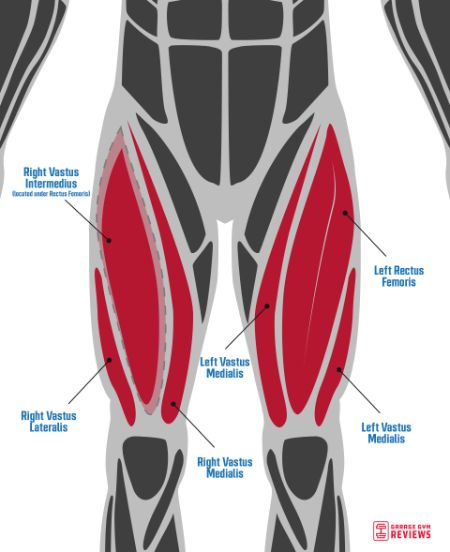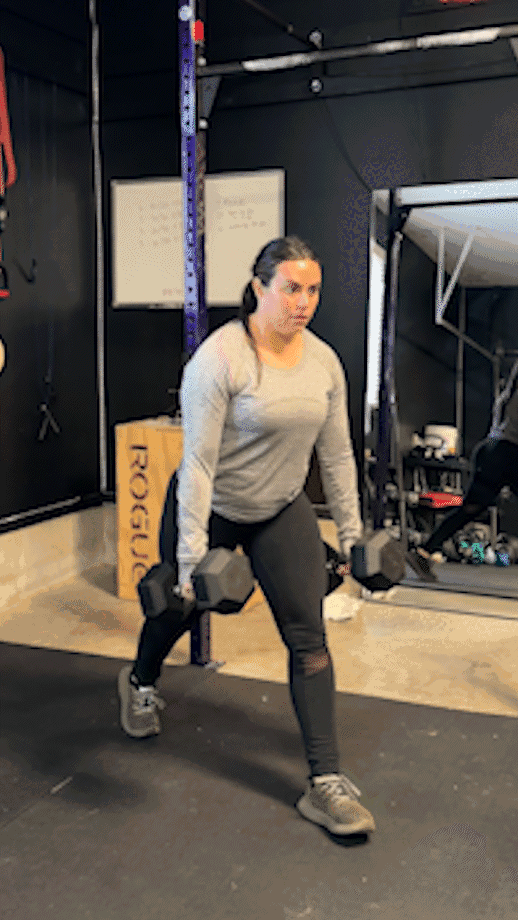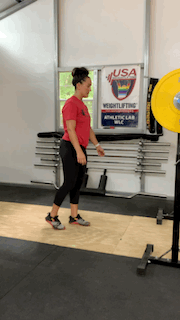We test and review fitness products based on an independent, multi-point methodology. If you use our links to purchase something, we may earn a commission. Read our disclosures.
Lots of folks are happy to blast reps of bicep curls and flex endlessly in front of the gym mirror, but they rarely bring that gusto when it’s time for some leg exercises. Some don’t even bother, content to leave leg day off the training schedule week after week.
Never skip leg day!
“Strong legs help you move more efficiently and generate more power during sports and exercise,” says certified personal trainer and GGR Head of Content Kate Meier. “Plus, strong leg muscles protect your hips, knees, and ankles.”
Today, we’re focusing on the quads and dishing out nine of the best quad exercises there ever were. Perform these to strengthen your lower body, build muscle in your quads, and enjoy a wide array of health and fitness benefits that help you live your best life.
What Are Your Quadriceps?

According to StatPearls1, “the quadriceps femoris is the most voluminous muscle of the human body.” Located on the front of your thigh, the quads consist of four muscles:
- Rectus femoris
- Vastus lateralis
- Vastus medialis
- Vastus intermedius
All of the quad muscles enable knee extension, while the rectus femoris also assists in hip flexion. They are “essential for daily activities, such as climbing stairs or getting up from a chair,” and enable other functional movements like walking, running, jumping, squatting, and doing lunge exercises.
Why Train Quads?
Your quadriceps support the knee joint, so building strength in the quads helps prevent injuries like ACL tears and patellar tendonitis. Strong quads also contribute to reduced knee pain for those suffering from conditions like osteoarthritis.
According to a 2014 study published in the Journal of Physical Therapy Science2, “quadriceps strengthening has beneficial effect on pain and function in patients with [osteoarthritis] knee” and “subjects having stronger quadriceps strength had less knee pain and better physical function as compared with those with the least strength.”
A 2019 double-blind randomized trial published by the British Journal of Sports Medicine3 further supported this observation, determining that low-load leg extension exercises could reduce patellofemoral pain by up to a whopping 93%.
Training your quads allows you to perform everyday activities more easily, perform athletic activities more efficiently, reduce existing joint pain, and reduce your overall risk of injury.
Muscle-Pumping Quad Workout
| Exercise | Sets | Reps |
| Back Squat | 5 | 5 |
| Forward Lunge | 4 | 8 to 12 |
| Bulgarian Split Squat | 4 | 8 to 12 |
| Leg Extension | 4 | 8 to 12 |
9 Quad Exercises Explained
Our picks for the best quad exercises are not just excellent for building leg strength. They could easily be integrated into a full-body workout. From bodyweight workouts to barbell lifts, here are the quad exercises and tips for proper form.
Move 1: Heels Elevated Goblet Squat
Why do it: Elevating the heels during your basic goblet squat shifts more of the workload onto the quads, increasing activation. You’ll also hit the glutes and core with this compound exercise.
How to do it:
- Place two weight plates on the floor and stand with your heels on top of them, slightly elevated. You want your feet roughly hip-width apart, toes facing forward, back straight, chest tall, and core braced.
- Hold a kettlebell or dumbbell into your chest.
- Lower your body by hinging your hips and bending your knees. Keep your weight on your heels for the full range of motion.
- Keep going until your thighs are parallel to the floor, then pause and push back into a standing position by driving from your heels.
- Repeat as needed.

Move 2: Forward Lunge
Why do it: Lunges are one of the best, most popular, and most versatile exercises for targeting the quads, hamstrings and glutes. They assist in correcting muscle imbalances, improving posture and balance, and could be tweaked to perform with or without weights.
How to do it:
- Stand tall with your feet hip-width apart and your core braced.
- Step forward with your left foot, dropping the right knee until both legs form 90-degree angles.
- Pause, then push off the floor with your left foot to step back into the starting position.
- Repeat for your right foot and left knee.
RELATED: What Muscles Do Lunges Work?

Move 3: Front Foot Elevated Split Squat
Why do it: The split squat already reinforced efficient movement patterns, improving stability in your hips and core, but elevating the front foot increases activation in the quads and glutes. You can choose to start with both feet on the floor initially and move to front-foot elevated as you get comfortable with the movement.
How to do it:
- From a standing position, step one leg forward and enter a split stance. You should be on the toes of your back foot, with the heel coming off the floor.
- Drop your back knee to the floor until it is almost touching. Simultaneously bend your front knee until both knees create 90-degree angles.
- Pause, then push using both legs to return to a standing position.
- Repeat as needed, then switch sides and repeat the whole set.

Move 4: Leg Extension
Why do it: Leg extensions are one of, if not the, most popular isolation exercises for the quads. Since they exclusively target the quadriceps, it’s common to tack a set of leg extensions onto the end of a leg workout for the perfect finisher.
How to do it:
- Using a leg extension machine, select the weight you want to use. You’ll sit with your back against the pad, knees bent. Your ankles should be pressing against the lower pads.
- With control, straighten your legs until they are fully extended.
- You can pause slightly at the top, then, with control, return to the starting position.
- Repeat as needed.
RELATED: How To Do Quad Extensions

Move 5: Front Squat
Why do it: Front squats are similar to the classic back squat, except the barbell (or dumbbell, kettlebell, or other weighted implement) is in front of the body instead. This placement places less strain on your lower back, increases core muscle activation, and provides the same strength and hypertrophy benefits to the quads, hamstrings, and glutes as the standard back squat alternative.
How to do it:
- Unrack a loaded barbell into the front rack position, resting the bar across the front of your shoulders and pointing your elbows forward. You want a tall chest, straight back, tight core, and your weight on your heels throughout the movement.
- Maintain the front rack position while lowering your body into a squat. Stop once your thighs are parallel with the floor.
- Pause, then drive from your heels and push your knees outward to return to a standing position. Fully extend your hips at the top of the movement.
- Repeat as needed.
RELATED: How to Squat Heavier

Move 6: Single-Leg Squat (Pistol Squat)
Why do it: Of the many squat variations at your disposal, pistol squats rank among the most challenging. If you’re coordinated enough to successfully perform pistol squats, you’ll enjoy great improvements in your quad strength, ankle and hip mobility, and balance.
How to do it:
- From a standing position, lift your left leg in front of you.
- Bring your hips back and slowly bend your right knee to descend.
- Push through the right heel and squeeze your glutes to stand back up.
- Alternate legs or complete all reps before switching sides.

Move 7: Back Squat
Why do it: There’s a reason the back squat ranks among the most useful and effective exercises of all time. The back squat targets various posterior chain muscles using a functional movement most people use constantly in everyday life, inspiring muscle growth and contributing to better all-around well-being.
How to do it:
- Unrack a loaded barbell onto the top of your back and shoulders.You want a tall chest, straight back, tight core, and your weight on your heels throughout the movement.
- Bring your hips back and bend your knees to lower your body into a squat. Stop once your thighs are parallel with the floor or at your desired depth.
- Pause, then drive from your heels and push your knees outward to return to a standing position. Fully extend your hips at the top of the movement.
- Repeat as needed.
RELATED: What Muscles Do Squats Work?

Move 8: Sissy Squat
Why do it: The name seems to suggest this movement is dainty and lackadaisical, but it’s actually named for King Sisyphus and it will annihilate your quadriceps while also hitting your core, calves, hip flexors and adductors, and glutes.
How to do it:
- Start with your feet shoulder-width apart and your heels raised. You can use squat wedges or a weight plate. During the movement, your toes will remain on the floor pointing forward.
- Bend your knees slightly. Make sure you have engaged your core to keep your upper body tight through the movement.
- Lower your body into a squat by leaning back slightly, pushing the knees forward.
- Hold the bottom of the movement for a pause.
- Push with your legs to return to the starting position.
- Repeat as needed.

Move 9: Bulgarian Split Squat
Why do it: The Bulgarian split squat takes your standard split squat and intensifies it by placing the back leg in an elevated position. You get great activation in a number of lower body muscles while simultaneously improving the mechanics of your hips, knees, and ankles.
How to do it:
- Start by facing away from a weight bench.
- Place one foot on the bench behind you. It may take time to figure out good spacing between you and the bench.
- Keeping a tall chest, bend your front knee and lower yourself into a squat until your front knee makes a 90-degree angle.
- Drive through your front heel to return to a standing position.
- Repeat as needed, then switch sides.

Quad Exercises: Final Thoughts
As an athlete and fitness enthusiast, working out your quads provides plenty of benefits in terms of improved muscle strength, size, and endurance.
However, quad strengthening is important even if you’re not super hardcore into fitness. Strong quads help you perform everyday activities with more ease, supporting healthy hips and knees and translating to less joint pain later in life.
By working some of our recommended quad exercises into your leg day routine, you too will enjoy improvements in your quad strength, contributing to an overall healthier lifestyle.
Quad Exercises: Q&A
What are three exercises for the quads?
If we had to choose only three, we’d pick the barbell back squat, lunge, and leg extension.
The barbell back squat ranks among the best all-around lifts, along with the bench press and deadlift. Regularly squatting improves muscle strength, size, and endurance, functional fitness, bone density, and athletic performance.
Likewise, lunges are a versatile bodyweight exercise that targets numerous lower body muscles. Plus, the variations seem endless, helping you stave off boredom during your workout routine. You’ve got the forward lunge, reverse lunge, walking lunge– need we go on?
Meanwhile, leg extensions are one of the only isolation exercises for the quads, making them the perfect finisher exercise after all the compound exercises during the rest of the session.
What is the No. 1 quad exercise?
What’s “best” depends on the criteria, but the back squat will earn the top spot in most categories. If you chose one and only one quad exercise, choose the back squat.
How do you hit all four quad muscles?
The leg extension is an isolation exercise that hits all four quad muscles, but the barbell back squat and leg press hit all four quad muscles along with the glutes and hamstrings.
What is the best exercise to build your quads?
The best exercise for you depends entirely on your fitness goals.
For all-around fitness, compound exercises like the back squat and lunge will build your quads while providing benefits throughout the full body.
Likewise, the leg extension is an isolation exercise that targets only the quads, making it an excellent way to progressively overload the muscle group for increased hypertrophy.
Our recommendation is to hit the compound exercises first, then finish your session with a heaping helping of leg extensions. For more personalized advice, don’t be shy to hire a CPT or other qualified fitness professional.
References
1. Bordoni B, Varacallo M. Anatomy, Bony Pelvis and Lower Limb: Thigh Quadriceps Muscle. [Updated 2022 May 10]. In: StatPearls [Internet]. Treasure Island (FL): StatPearls Publishing; 2023 Jan
2. Anwer S, Alghadir A. Effect of isometric quadriceps exercise on muscle strength, pain, and function in patients with knee osteoarthritis: a randomized controlled study. J Phys Ther Sci. 2014;26(5):745-748. doi:10.1589/jpts.26.745
3. Giles L, Webster KE, McClelland J, Cook JL. Quadriceps strengthening with and without blood flow restriction in the treatment of patellofemoral pain: a double-blind randomised trial. Br J Sports Med. 2017;51(23):1688-1694. doi:10.1136/bjsports-2016-096329
Further reading

Looking for the best resistance bands to add to your home gym? Look no further, because the GGR team has compiled our top picks for every need. Read more

Lots of folks are happy to blast reps of bicep curls and flex endlessly in front of the gym mirror, but they rarely bring that gusto when it’s time for some leg exercises. Some don’t even bother, content to leave leg day off the training schedule week after week.Never skip leg day!“Strong legs help you move more efficiently and generate more power during sports and exercise,” says certified personal trainer and GGR Head of Content Kate Meier. » Read more about: The 9 Best Quad Exercises to Build Bigger, Stronger Legs » Read more

Our Greens First review looks at the nutritional profile of this greens powder to determine if it’s worth buying. Read more

Lots of folks are happy to blast reps of bicep curls and flex endlessly in front of the gym mirror, but they rarely bring that gusto when it’s time for some leg exercises. Some don’t even bother, content to leave leg day off the training schedule week after week.Never skip leg day!“Strong legs help you move more efficiently and generate more power during sports and exercise,” says certified personal trainer and GGR Head of Content Kate Meier. » Read more about: The 9 Best Quad Exercises to Build Bigger, Stronger Legs » Read more

